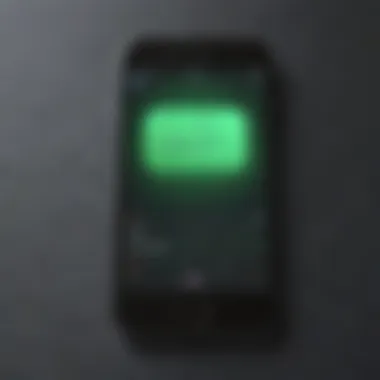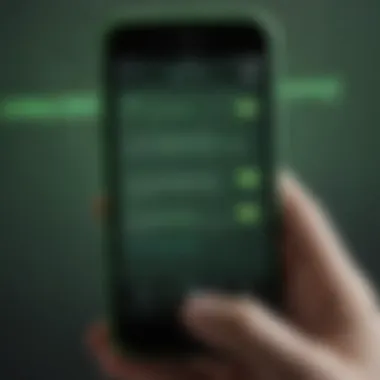Understanding Green Text Messages: Causes and Implications


Intro
In today’s fast-paced digital communication landscape, the way we send and receive messages can significantly impact our interactions. One often overlooked detail is the color of text messages. When a message appears green on an iPhone, it signifies that the message is being sent via SMS rather than iMessage. Understanding the reasons behind this distinction is crucial for anyone engaged in mobile communication.
The shift from the familiar blue of iMessage to green SMS can provoke various reactions among users. From technical limitations to social implications, green text messages tell a story that encompasses both how our devices interact and our perceptions of communication. This article aims to delve into the complexities surrounding green text messages, providing a clearer picture of their significance for users.
Overview of the Messaging Systems
Mobile communication has transformed dramatically with the advent of smartphones. Two primary messaging systems dominate the landscape: SMS and iMessage. Knowing the differences between these platforms can illuminate the reasons behind those green messages.
SMS vs. iMessage
SMS (Short Message Service) is a standard communication protocol used by mobile devices to exchange text messages. It is universally supported by all mobile phones, allowing messages to be sent and received regardless of the device used. However, SMS lacks advanced features such as encryption and multimedia sharing.
On the other hand, iMessage is an Apple-exclusive service that leverages internet connection for sending messages. It allows for richer communication options, including read receipts, typing indicators, and media sharing. Knowing how these systems operate is foundational to understanding why messages switch to green.
"The color of your text message can signify the underlying technology at work, shaping not just how you communicate but also how others perceive that communication."
Causes of Green Text Messages
There are several reasons why your messages may turn green. Understanding these factors can help you troubleshoot and navigate your texting experience more effectively.
Reasons for Green Messages
- Recipient's Device Type: If the recipient does not use an Apple device, your iMessage will revert to SMS. This is a fundamental characteristic of cross-communication.
- Network Availability: iMessage requires internet access, either through Wi-Fi or cellular data. If your device cannot connect, messages will send via SMS.
- Account Settings: Sometimes, simply tweaking the iMessage settings can resolve issues. Users can ensure their iMessage is activated in settings for optimal performance.
- Recipient's iMessage Settings: If someone has turned off iMessage or has not set it up correctly on their device, messages will default to green.
- Temporary Technical Flaws: Network disruptions or technical outages might lead to temporary switching to SMS as well.
Implications of Green Text Messages
The social and personal ramifications of receiving a green text message can be profound. It can influence how communication is perceived among users.
Social Perceptions
- Status Symbol: For some iPhone users, blue messages signify exclusivity and an implicit understanding among peers. A green message may not carry the same weight.
- Technical Competence: The distinction may lead to assumptions about technical proficiency or device preference. This can color perceptions in group chats and social interactions.
- Privacy Concerns: iMessage includes encryption, making it a more secure option for users concerned about privacy. The switch to SMS could potentially inhibit this sense of security.
Epilogue
Understanding why text messages turn green can demystify aspects of mobile communication. This knowledge is essential for avid smartphone users and tech enthusiasts alike. By exploring the causes and implications of green messages, individuals can navigate their texting experiences with greater clarity and confidence.
Prelude to Text Messaging
Text messaging holds an essential place in modern communication. It serves as a fundamental means for people to engage with one another, whether for personal conversations or professional interactions. Understanding text messaging is particularly vital in the context of how these messages are formatted and displayed on our devices. Notably, the colors associated with texts can significantly influence user perception and experience.
When a user sends a text message, they might encounter blue or green text bubbles. This color coding can reflect various underlying technical factors. It is important for users to familiarize themselves with these details, as they influence message delivery methods and user interactions.
Moreover, being aware of the implications behind these color changes can affect social dynamics, especially in contexts where communication is crucial. Knowing whether a message is sent via iMessage or SMS can help users understand potential limitations, read receipts, and even privacy concerns.


This section explores the historical and technical background of text messaging that sets the stage for a deeper dive into the phenomenon of green text messages.
Color Coding in Messaging
Color coding in messaging plays a vital role in helping users identify the nature of their communication. In the context of mobile texting, this phenomenon primarily manifests through color differences between text messages. For instance, iMessages from Apple appear in blue bubbles, while standard SMS messages appear in green bubbles. Understanding this distinction is particularly beneficial for smartphone users to navigate their messaging experience more effectively. It also underscores the technological underpinnings that separate these two forms of communication.
Meaning of Blue vs. Green Messages
The difference between blue and green messages goes beyond mere aesthetics. Blue messages indicate that the person you are texting is also using an Apple device with iMessage enabled. This means the messages are sent over the internet, enabling features such as read receipts, typing indicators, and high-quality image sharing. On the other hand, green messages denote that the text was sent via SMS. This universally recognized protocol lacks many of the advanced features offered by iMessage and often has limitations like lower media quality and no read receipts.
This distinction is important because it potentially alters how recipients perceive their interactions. Messages in green might suggest that communication is not as seamless or immediate as it would be in blue. Moreover, Apple users tend to associate blue messages with privacy and sophisticated communication options.
Understanding iMessage and SMS Differentiation
To fully grasp the implications of green messages, one must understand the technical foundations of iMessage and SMS. iMessage uses Apple’s proprietary protocol, which relies on an internet connection rather than traditional cellular networks. This allows it to function on Wi-Fi and any data plan without incurring extra costs. SMS, however, is governed by mobile carrier protocols. It operates over cellular networks and can be sent to any mobile number, irrespective of the recipient's device type.
The differentiation between these two messaging systems impacts user experiences significantly. For instance, a user sending a mixed group message might unintentionally revert to SMS if even one recipient does not have iMessage. This can lead to communication delays and confusion. Furthermore, SMS is often subject to limitations like character count and potential delays, which can affect time-sensitive communications.
In summary, color coding in messaging serves as a visual cue to users, promoting clarity in their text interactions. Understanding the meanings behind blue and green messages is crucial for effective communication, especially within diverse device ecosystems.
Factors Leading to Green Text Messages
The appearance of green text messages can be confusing for many smartphone users. Understanding the factors that lead to these green messages is crucial in today’s mobile communication landscape. The distinction between blue and green is more than a color; it highlights significant technical and social implications. Being aware of these factors can aid users in navigating their messaging experience more effectively.
Device Compatibility Issues
A major cause of green text messages is device incompatibility. Users rely heavily on their devices to send and receive messages. However, if one party uses an iPhone and the other a non-Apple device, messages will appear green. This happens because iMessage, Apple's proprietary messaging system, does not function between different operating systems. Consequently, messages sent from iPhones to Android or outdated iPhones resort to SMS, resulting in green text bubbles.
Selecting an incompatible device, or attempting to communicate with someone using different types of devices, can impact the fluidity of conversations. Users need to factor in the nature of the devices when planning interactions. Moreover, as technology evolves, the importance of understanding device compatibility will persist.
Network Connection Problems
Network connectivity plays a vital role in text messaging functionality. Often, inadequate or unstable network connections lead to SMS instead of iMessage being utilized. Factors such as poor cellular signal or weak Wi-Fi can cause messages to default to green text.
In high-traffic areas, network load can hinder the ability to send messages seamlessly. When signal strength is compromised, users might find their messages delayed or, at times, failed. This underlines the importance of ensuring a good data connection when expecting a seamless messaging experience. Reliable networks contribute significantly to preventing miscommunications that can arise from green text messages.
User Settings Misconfigurations
Yet another common reason for green text messages is user settings misconfigurations. Users may unknowingly alter settings that dictate message sending preferences. For instance, if the iMessage feature is disabled on an iPhone, all messages will revert to standard SMS, showing as green.
Users should frequently review their messaging options to ensure they align with their communication needs. This includes verifying that iMessage is activated, checking for any software updates, and making sure notifications are enabled. Notably, awareness of these settings can enhance overall communication effectiveness and reduce the instances of unexpected green text messages.
By understanding these factors leading to green text messages, users can make informed decisions about their messaging experiences. This knowledge not only fosters clearer communication but also helps mitigate potential misunderstandings inherent in text messaging.
The Role of Internet Connectivity
Internet connectivity serves a fundamental role in modern text messaging. Understanding its impact is essential to grasp the nuances behind the color of text messages, particularly the shift from blue to green. This transition can signify a plethora of underlying issues, mainly centered around how messages are transmitted and received.


How Wi-Fi and Cellular Data Affect Messaging
Wi-Fi and cellular data represent two primary avenues through which messages can be sent. When using iMessage, messages are transmitted over the internet, allowing for faster delivery and the inclusion of multimedia elements. If a device is connected to Wi-Fi, it utilizes this network to deliver messages, enhancing the speed and efficiency. However, should the Wi-Fi signal waver or fail, the device will resort to cellular data if available.
Conversely, SMS messages do not rely on internet connection. They use the cellular network, making them a more reliable method when data service is limited. This difference is critical. If you see a green message, it often means that the message has defaulted to SMS due to unavailable internet connection for iMessage.
Impact of Weak Signals
Weak signals can significantly disrupt messaging experiences. If you are in an area with insufficient Wi-Fi or cellular coverage, your messages may fail to deliver as intended. This inadequacy can lead to increased reliance on SMS protocols, thus resulting in green messages. It is essential to recognize that weak signals not only affect message delivery but can also prevent other functionalities like media sharing, read receipts, and typing indicators from appearing.
In summary, the quality of your internet connection directly influences how messages are sent and perceived. A stong signal can facilitate seamless communication, while weak connections can lead to undesirable experiences and misunderstandings.
A stable internet connection is crucial for optimal text messaging, ensuring messages are sent in their intended format.
By comprehending these factors, avid smartphone users and tech enthusiasts can appreciate the technical underpinnings of messaging systems and navigate the complexities of their devices more efficiently.
Implications of Green Messages for Users
The appearance of green text messages can carry significant implications for users. Understanding these effects is crucial for many smartphone users and tech enthusiasts. While green messages are simply SMS texts, they can evoke certain perceptions. Moreover, knowing the potential downsides can guide users in managing their messaging experience effectively.
Social Perceptions and Misunderstandings
Green messages can lead to social perceptions that impact user relationships. When someone receives a green message instead of a blue one, it can create assumptions about the sender's device. This may cause feelings of exclusion among iPhone users. For instance, a user might think, "Did they switch to Android?" or "Are they using an outdated phone?" Such thoughts can prompt misunderstandings.
Additionally, the social psychology linked to messaging colors is intriguing. Users often equate blue messages with status and connection. A green text can signify detachment, even if that is not the case. People may misinterpret a green message as a sign of negligence or a lack of interest.
"The color codes in messaging are not just about technology; they have real social implications."
Potential for Missed Messages and Errors
Another implication of green messages includes the increased potential for missed communications. SMS does not have the same delivery confirmations or read receipts as iMessage. Users may not receive notifications about whether their messages were seen. This can lead to confusion in conversations, as the sender may not know if their message was delivered successfully.
Moreover, the simplicity of SMS may also cause errors. For example, a user trying to communicate a delicate issue may prefer iMessage for its privacy features. However, if a message defaults to green, the user risks their important communication being overlooked.
To manage these issues, users can consider the following steps:
- Confirm Sender and Receiver has the same App: Ensuring both parties use compatible messaging platforms can alleviate many problems.
- Verify Network Connection: Poor connectivity can disrupt message delivery, causing frustrations and potential mix-ups.
- Be Clear in Communication: Specify important details that need urgent attention. This ensures that even if the message is green, the content stands out.
Troubleshooting Green Text Messages
Green text messages can indicate various underlying issues and bring confusion among users. Thus, understanding how to troubleshoot these scenarios becomes quite important. It is essential to identify any specific problem to restore seamless communication between devices. Ultimately, resolving these issues not only enhances the user experience but also ensures that important messages are not missed.
Checking Device Settings
Start with checking the settings on your device. Each smartphone has specific configurations that may impact messaging functionalities. For instance, a common reason for green texts is related to message settings that affect sending as iMessage or SMS. On an iPhone, go to Settings, then select Messages. Here, ensure that iMessage is toggled on. If the device requires a valid Apple ID, verify that it is correctly entered.


Moreover, check if sending as SMS is enabled. This helps ensure that if iMessage fails, messages can still go through as standard texts. For Android users, similar settings can be found within their messaging app settings. It’s vital to have appropriate permissions granted for messaging apps to function correctly.
Testing Network Connectivity
Network connectivity plays a crucial role in determining how messages are transmitted. Poor or unstable Wi-Fi or cellular data can lead to messages being sent through SMS, resulting in green text. Begin by testing your network connection. You can toggle airplane mode on and off to refresh the connection. Additionally, verify that you are connected to a strong Wi-Fi signal or that cellular data is enabled. If not, consider resetting network settings. Be aware that network congestion may also affect message delivery times. Testing network connectivity is a necessary step for effective communication.
Updating Messaging Apps and Operating Systems
Lastly, ensure that your messaging apps and operating systems are up to date. Application updates often include enhancements and bug fixes that improve overall performance. On iOS, go to Settings > General > Software Update to check if a new version of iOS is available. For Android devices, updates can usually be found under Settings > System updates.
Similarly, visit the App Store or Google Play Store to check for updates on specific messaging apps. Outdated applications might not support newer protocols that facilitate better messaging services. Keeping your device and applications updated helps minimize the probability of encountering green messages.
Remember that even small inconsistencies in settings can lead to major communication barriers. Regular checks can prevent potential messaging mishaps.
Alternatives to SMS and iMessage
In today’s digital age, mobile communication has evolved far beyond traditional SMS and iMessage. The rise of alternative messaging platforms has become increasingly significant for users who seek more functionality, customization, and security. Understanding these alternatives is crucial for anyone who wishes to enhance their communication experience and avoid potential pitfalls associated with green text messages.
Exploring Third-Party Messaging Applications
Many users are unaware of a variety of third-party messaging applications available that can provide enhanced features, better connectivity, and alternative ways to communicate. Applications such as WhatsApp, Telegram, Signal, and Facebook Messenger have gained popularity due to their ease of use and advanced capabilities. These platforms often offer end-to-end encryption, which is a vital feature for those concerned about privacy.
- WhatsApp: Known for its user-friendly interface, it allows not only text but also voice and video calls, all without using SMS.
- Telegram: This app is praised for its focus on speed and security. Multiple device support makes it ideal for users who switch between devices.
- Signal: Considered one of the most secure messaging apps, it offers advanced privacy settings, attracting users who prioritize confidentiality.
- Facebook Messenger: It integrates easily with Facebook services, allowing users to share media and documents in real-time.
These applications bypass traditional SMS protocols, which helps mitigate the issues leading to green text messages. With a solid internet connection, users can communicate seamlessly without worrying about potential misconfigurations or compatibility problems that often lead to the green message phenomenon.
Selecting the Right Platform for Communication
Choosing the right messaging platform depends on several factors, including personal needs, the nature of communication, and desired features. Here are some considerations:
- Usability: Consider whether the application is easy to navigate and understand.
- Features: Evaluate what extra features the app provides, such as file sharing, video calls, and group chats.
- Security: Look for platforms that offer privacy protections, especially if sensitive information will be shared.
- Compatibility: Ensure the app is compatible with the devices and operating systems used by communication partners.
- User Base: If most of your contacts use a particular platform, it might make sense to adopt that application for ease of communication.
"Selecting the right messaging platform is key to ensuring that your texts are delivered as intended, minimizing the undesirable green message experience."
Epilogue
Concluding a discussion about green text messages serves as a crucial part of understanding mobile communication. It emphasizes the significance of recognizing the technical aspects behind why messages may appear in green, rather than blue. The distinction between SMS and iMessage is not merely a technical curiosity; it has real implications on user experience.
Summarizing Key Points
In this article, we have explored several key elements regarding green text messages:
- Technical Differences: We explained the technical aspects that lead to SMS messages showing up in green rather than blue, highlighting how these differences stem from device compatibility and network conditions.
- Social Implications: It was pointed out how color coding in messaging can lead to social misunderstandings, influencing a user’s perception of their communication.
- Troubleshooting Strategies: Practical advice for addressing common issues related to green messages has been provided. This includes checking device settings and testing network connectivity.
- Alternatives to SMS and iMessage: We also examined third-party messaging platforms that users might consider for improved communication experiences.
Encouraging informed texting practices
Encouraging informed texting practices is essential for users in today’s digital communication landscape. By understanding the implications of green text messages, users can take proactive measures:
- Checking Settings: Users should routinely verify their messaging settings, ensuring optimal configurations for their devices.
- Awareness of Compatibility: Being educated about the compatibility of devices and services can help clarify expectations when sending messages.
- Exploration of Alternatives: Encouraging exploration of third-party messaging apps can open avenues for enhanced functionality and user experience.
By promoting a culture of informed texting, users can reduce anxiety and misunderstandings, fostering clearer, more reliable communication.
Understanding the technical details behind your communication tools can significantly enhance both your satisfaction and effectiveness in messaging.



